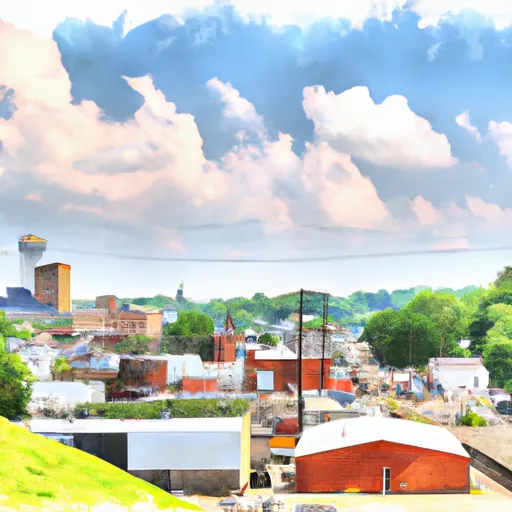-
 Snoflo Premium
Snoflo Premium
Get unlimited access to all our content
With no Ad interruptions! - Start Your Free Trial Login with existing account
Thelma
Eden Index
Climate
8.3
•
Recreation
3.7
•
Community
2.7
•
Safeguard
5.3/10

Thelma, Kentucky is a small community located in Johnson County. The climate in Thelma is classified as humid subtropical, characterized by hot and humid summers and mild winters. The average temperature ranges from the mid-80s°F (29°C) in summer to the mid-30s°F (1-2°C) in winter. Precipitation is fairly evenly distributed throughout the year, with slightly higher amounts during the summer months.
Thelma is situated near the Big Sandy River, which contributes to the hydrology of the region. The river is an important water source for the area, providing opportunities for fishing, boating, and other water-based activities. Additionally, there are several smaller creeks and streams that flow through Thelma, adding to the hydrological landscape.
Outdoor recreation opportunities in Thelma are abundant. The area is surrounded by scenic natural beauty, offering opportunities for hiking, camping, and wildlife viewing. Local parks and trails provide spaces for picnicking, walking, and enjoying nature. The nearby mountains and forests also attract outdoor enthusiasts who enjoy activities such as hunting, ATV riding, and horseback riding.
Overall, Thelma, Kentucky offers a pleasant climate, diverse hydrology, and a variety of outdoor recreation opportunities, making it an inviting destination for nature lovers and outdoor enthusiasts.
What is the Eden Index?
The Snoflo Eden Index serves as a comprehensive rating system for regions, evaluating their desirability through a holistic assessment of climate health, outdoor recreation opportunities, and natural disaster risk, acknowledging the profound impact of these factors on livability and well-being.
Climate Health Indicator (CHI): 8.3
Thelma receives approximately
1125mm of rain per year,
with humidity levels near 83%
and air temperatures averaging around
13°C.
Thelma has a plant hardyness factor of
6, meaning
plants and agriculture in this region thrive during a short period during spring and early summer. Most
plants will die off during the colder winter months.
By considering the ideal temperature range, reliable water supplies, clean air, and stable seasonal rain or snowpacks, the Climate Health Indicator (CHI) underscores the significance of a healthy climate as the foundation for quality living.
A healthy climate is paramount for ensuring a high quality of life and livability in a region, fostering both physical well-being and environmental harmony. This can be characterized by ideal temperatures, reliable access to water supplies, clean air, and consistent seasonal rain or snowpacks.
Weather Forecast
Streamflow Conditions
Big Sandy
Area Rivers
Big Sandy
Snowpack Depths
Big Sandy
Reservoir Storage Capacity
Big Sandy
Groundwater Levels
Recreational Opportunity Index (ROI): 3.7
The Recreational Opportunity Index (ROI) recognizes the value of outdoor recreational options, such as parks, hiking trails, camping sites, and fishing spots, while acknowledging that climate plays a pivotal role in ensuring the comfort and consistency of these experiences.
Access to outdoor recreational opportunities, encompassing activities such as parks, hiking, camping, and fishing, is crucial for overall well-being, and the climate plays a pivotal role in enabling and enhancing these experiences, ensuring that individuals can engage in nature-based activities comfortably and consistently.
Camping Areas
| Campground | Campsites | Reservations | Toilets | Showers | Elevation |
|---|---|---|---|---|---|
| Portal 31 RV Park | 20 | 1,841 ft | |||
| German Bridge - Dewey Lake | 40 | 653 ft | |||
| Natural Tunnel State Park | None | 1,703 ft | |||
| Flag Rock Recreation Area | 21 | 2,461 ft | |||
| High Knob | 77 | 3,608 ft | |||
| Littcarr - Carr Creek Lake | None | 1,050 ft | |||
| Jenny Wiley State Park | 115 | 857 ft | |||
| Horse Creek Rec Area | 34 | 1,759 ft | |||
| Davy Crockett Birthplace | 88 | 1,392 ft | |||
| Cane Patch | 34 | 1,672 ft |
Nearby Ski Areas
Catastrophe Safeguard Index (CSI):
The Catastrophe Safeguard Index (CSI) recognizes that natural disaster risk, encompassing floods, fires, hurricanes, and tornadoes, can drastically affect safety and the overall appeal of an area.
The level of natural disaster risk in a region significantly affects safety and the overall livability, with climate change amplifying these risks by potentially increasing the frequency and intensity of events like floods, fires, hurricanes, and tornadoes, thereby posing substantial challenges to community resilience and well-being.
Community Resilience Indicator (CRI): 2.7
The Community Resilience Indicator (CRI) recognizes that education, healthcare, and socioeconomics are crucial to the well-being of a region. The CRI acknowledges the profound impact of these elements on residents' overall quality of life. By evaluating educational resources, healthcare accessibility, and economic inclusivity, the index captures the essential aspects that contribute to a thriving community, fostering resident satisfaction, equity, and social cohesion.

